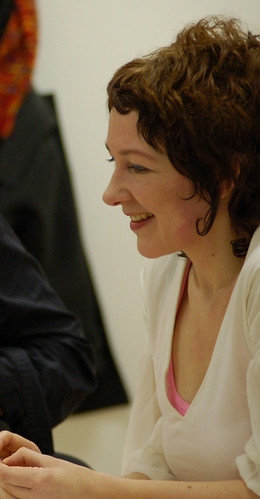


“(I mixed hydrochloric acid with sulfuric nitrate…“. Photo: Stéphanie Delcroix
At the end of last year (as you can see, we are still commenting on current events in real-time), the New York Public Library “summit”
Revolutions in Public Practice
, organized by
Creative Time
, took place. Claire Bishop then published in
Artforum
this controversial chronicle of the event, as it stirred up a trail of comments, including those of some of the event’s own participants. Revolutions in Public Practice was presented as a kind of marathon
Pecha kucha
during which an eclectic and large group of artists, curators, critics, academics, anarchists (sic) and activists” offered a series of “concise presentations” on their work. The term “public practice” served to amalgamate the motley group of speakers who, according to the project’s presentation text, have in common an approach to artistic practice that “does not attempt to reflect, but to act on moments of historical change, breaking down the traditional barriers between art, culture and politics“; in short, what is supposed to be the latest batch of what Suzanne Lacy – who also spoke at the summit – called “new genre public art.”
Bishop concludes her article by saying that nothing was done during the summit to problematize “public practices” as a valid direction in contemporary art, and that it was assumed as an unquestionable fact that “art as a discipline can and should be recruited” in the struggle for “social justice.” What Bishop ultimately missed during the summit is a “weighing of the specifically artistic skills that can be used for these purposes” (the emphasis is ours).
In February 2006, Bishop published (also in Artforum) a much longer text on this issue. Entitled
Bishop’s reasoning is apparently logical, however, it only holds if we move within the limits of the artistic field as it is established. In reality, we can say that, intentionally or not, collaborative art projects, or whatever they may be called, propose and attempt to put into practice modes of cultural production that do not pass, or rather, that partially pass through the modes of production, distribution and valuation of the artistic field (those of museums and galleries, curators and art critics, etc.); and in them, other agents and institutions come into play that are not exclusively those of art, and that have different objectives and criteria of valuation. If we understand that the artist is someone whose position in the social field allows him to access certain material and symbolic resources, the differences between artists could be measured in the way in which some and others put these resources to work, meshing them here and disuniting them there from such or such area of production.
The “self-sacrifice” “authorial” criticized by Bishop is not, or should not be, a moral action, but a political one, which pursues a redistribution of the possibilities of constructing and giving representations by subaltern action groups. It is not at all about “democratizing access to culture”, since that is a maxim of the dominant action groups and which takes for granted that ‘the culture’ to which the rest must access is theirs, that which shapes and supports the ‘structures of attitude and reference’ (to speak in the terms of Edward Said) that perpetuate the regime that has placed them in the hegemonic position they hold.
Returning to the issue raised by Claire Bishop, if there is a moral dilemma here, it would be that of the artist who instrumentalizes any groups or collectives that come his way for the sole purpose of giving himself a socially committed veneer within the field of art and having only his advancement and his interest as an art professional in mind. To tell the truth, the moral question should not matter to us here either: that the artist has behaved like a heartless person using the unsuspecting group of African immigrants in order to be selected for such or such public art festival is irrelevant if, for practical purposes, the situation of said collective has improved substantially in some aspect; after all, believing in someone’s good or bad will is, in a certain sense, an act of faith. Once again, the problem is not ethical, it is not about the degree of purity of the artist’s conscience, but political; it is useless for such or such collective to benefit from specific projects if the artists use this fact to affirm and reproduce the forms of social distinction that are articulated through the field of art.
In any case, Claire Bishop develops her thesis in a much more extensive and documented way, which makes reading her articles quite recommendable; if you also want to delve into the reactions that it aroused at the time, it is not bad to read the extensive open letter that
Grant Kester
himself (one of the most serious theoretical champions of “community art” and cited by Bishop in his article The social turn: collaboration and its discontents) sent to Artforum; on the other hand,
Randall Szott
sagaciously comments on the dialectical brawl here and especially here on his blog LeisureArts. Bishop returns to the topic in this interview published a few months after the famous article on the website of the Community Arts Network, in which she relates her theoretical position to the fact of living in the United Kingdom, where Labor’s policies of social inclusion through the arts constitute, in Bishop’s opinion, a kind of ‘soft way’ of eradicating dissent.